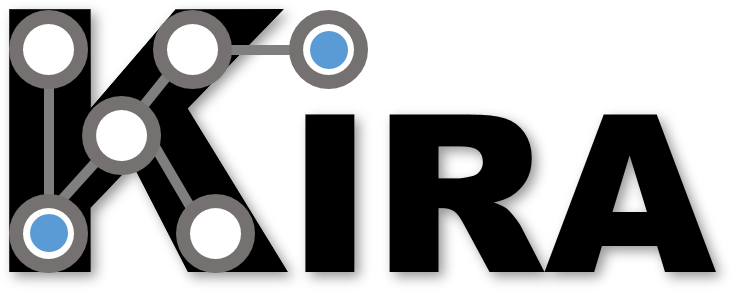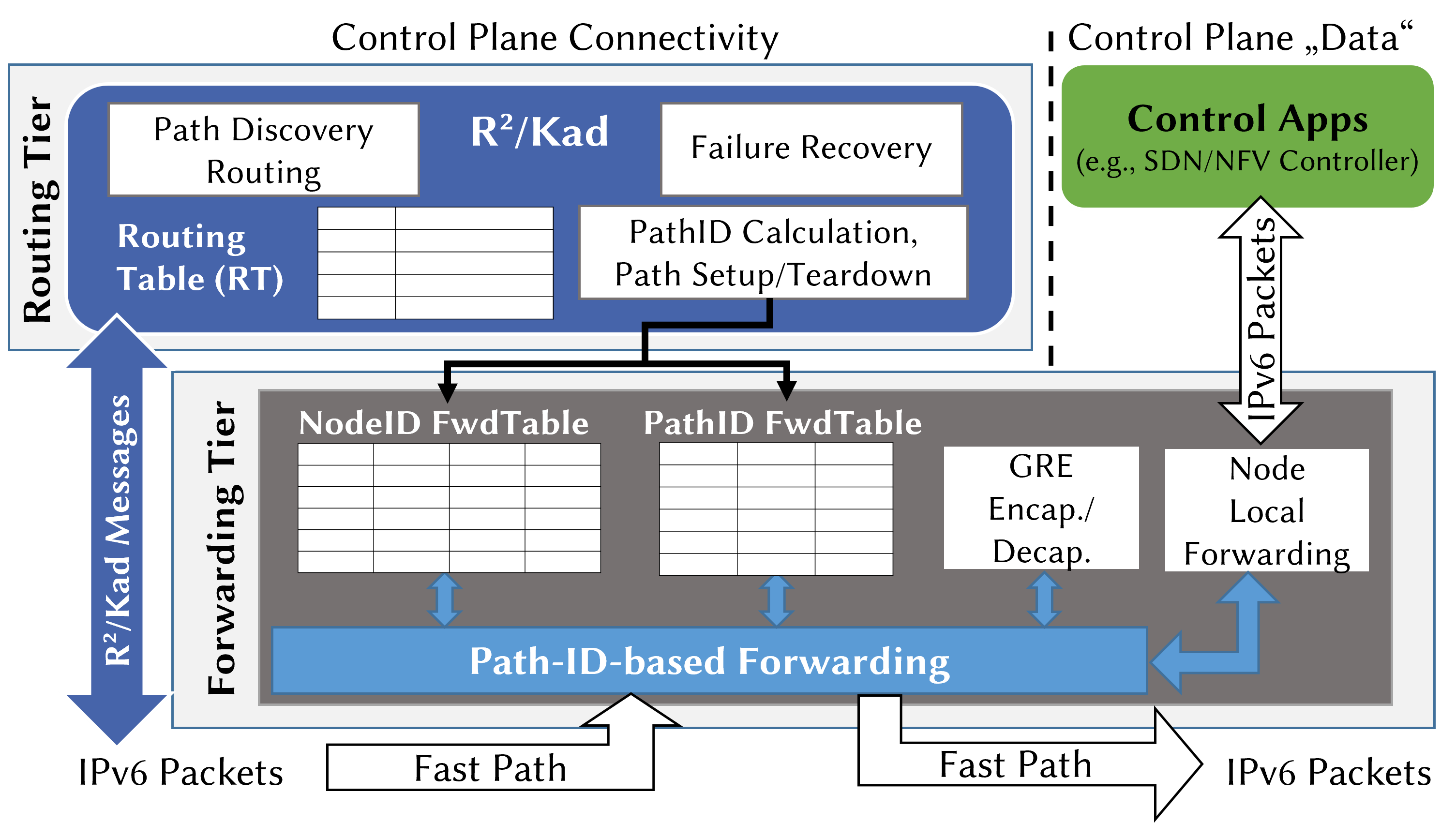KIRA
- contact:
- project group:
Future Network Management
- funding:
internal project
- Partner:
Hendrik Mahrt, Paul Seehofer
- enddate:
ongoing
 Kademlia-directed ID-based Routing Architecture
Kademlia-directed ID-based Routing Architecture
Scalable Zero-Conf Routing for Control Planes. KIRA provides scalable IPv6 connectivity (100,000s of nodes) across a link-layer topology without any configuration and thus provides a resilient foundation for autonomic networks.
KIRA Project Description

Short Description
KIRA is a scalable zero-touch routing solution that is tailored to control planes, i.e., in contrast to commonly used routing protocols like OSPF, ISIS, BGP etc., it prioritizes resilient connectivity over route efficiency. It scales to hundreds of thousands of nodes in a single network, it uses ID-based addresses, is zero-config and is able to work well in various network topologies. Moreover, it offers a flexible memory/stretch trade-off per node, shows fast recovery from link or node failures, and is loop-free, even during convergence. Additionally, it includes a built-in Distributed Hash Table (DHT) that can be used for simple name service registration and resolution, thereby helping to realize autonomic network management and control and zero-touch deployments. Moreover, we designed KeLLy, a highly scalable and fast topology discovery on top of KIRA that allows to discover large network topologies by querying only 4% of the nodes.

KIRA is composed of R²/Kad in the routing tier and of a PathID-based forwarding scheme in its forwarding tier. R²/Kad constructs underlay routes by using a Kademlia-directed ID-based overlay routing strategy and uses source routing between the overlay hops. For control plane packets source routing would induce some per-packet overhead that is avoided by replacing the source routes with PathIDs. PathIDs are similarly used as in label switching and can be partially calculated beforehand. So KIRA establishes a control plane fabric that provides zero-touch connectivity between all networked resources in a scalable manner. Control plane elements such as SDN controllers, Kubernetes controllers, Path Computation Elements, Management servers, and so on can run on top of this control plane fabric. We see such a solution as a foundation that is required for (future) network automation as it constitutes a reliable base for network control that will always work if there is physical connectivity available between the entities.
The first concept was developed April 2018.
Publications
- R. Bless, M. Zitterbart, Z. Despotovic and A. Hecker, "KIRA: Distributed Scalable ID-based Routing with Fast Forwarding", 2022 IFIP Networking Conference (IFIP Networking), Catania, Italy, 2022, doi: 10.23919/IFIPNetworking55013.2022.9829816. https://ieeexplore.ieee.org/document/9829816
(or download the preprint version).- this is a first publication explaining KIRA
- Position Paper: R. Bless: An Invariant for Future Resilient Network Management Operations, Position paper at the IAB NEMOPS (Next Era of Network Management and Operations) Workshop (online), November 2024 (PDF).
- RIPE Labs Article: R. Bless: How To Never Lose Control Over Your Network, RIPE Labs, online , April 2025
Related Publications
- P. Seehofer, R. Bless, H. Mahrt, M. Zitterbart, "Scalable and Efficient Link Layer Topology Discovery for Autonomic Networks", 19th International Conference on Network and Service Management (CNSM) 2023, 30th Oct–Nov 2nd, Niagara Falls, Canada, doi: 10.23919/CNSM59352.2023.10327800, https://ieeexplore.ieee.org/document/10327800, (PDF)
- this is an improved version of the scalable and fast topology discovery based on KIRA
- P. Seehofer, R. Bless, M. Zitterbart, "KeLLy: Scalable, Efficient Link-Layer Topology Discovery", 2023 NOMS IEEE/IFIP Network Operations and Management Symposium, 36th IEEE/IFIP Network Operations and Management Symposium (2023), Miami, FL, USA, 08.05.2023 – 12.05.2023, https://ieeexplore.ieee.org/document/10154355
- this is a scalable and fast topology discovery based on KIRA
- M. -I. Corici, F. Eichhorn, R. Bless et al., "Organic 6G Networks: Vision, Requirements, and Research Approaches", in IEEE Access, July, 2023, https://ieeexplore.ieee.org/document/10175535, doi: 10.1109/ACCESS.2023.3293055
- this describes the use of KIRA for providing a control plane fabric for a 6G organic core infrastructure
- P. Seehofer, H. Mahrt, R. Bless, M. Zitterbart, "Enabling Autonomic Network Infrastructures with KIRA", Demo paper SIGCOMM 2023, NY, USA
- this demonstrator shows the use of KIRA and its integrated DHT as foundation for 5G control plane connectivity and autonomous 5G core infrastructures (using Open5GS on top of KIRA's IPv6 connectivity). https://dl.acm.org/doi/10.1145/3603269.3610864
Internet-Draft(s)
See https://datatracker.ietf.org/doc/draft-bless-rtgwg-kira/
This is a protocol specification for the base protocol in order to implement the protocol.
Talks/Slides
- 124th IETF Meeting (Nov 2025, Montréal)
- KIRA Side Meeting: Slides (PDF)
- 123rd IETF Meeting (Jul 2025, Madrid)
- KIRA Side Meeting KIRA Side Meeting Slides
- 121st IETF Meeting (Nov 2024, Dublin)
- Munich Internet Research Retreat Raitenhaslach (MIR³) 2023: KIRA – Scalable Zero-Touch Routing for Autonomic Control Planes, November 2023
- 118th IETF Meeting (Nov 2023, Prague)
- 115th IETF Meeting (Nov 2022, London)
- Dagstuhl Seminar 22471 Towards More Flexible and Automated Communication Networks, November 2022
Theses
Several student theses have been conducted in the context of KIRA (or KeLLy)
- Rico Rußi, Evaluation and Adaptation of the Routing Architecture KIRA for Use in Mobile Ad-Hoc Networks (in german), Bachelor Thesis, April 2025
- Jens Greiner, Usage of the Routing Architecture KIRA in LEO Satellite Networks, Bachelor Thesis, March 2025
- Elias Schaut, Evaluation of the Routing-Architecture KIRA in Mobile Ad-Hoc Networks (in german), Bachelor Thesis, June 2024
- Timon Reinold, Modeling User Equipment Mobility in RoutingSim and Evaluating its Impact on KIRA, Bachelor thesis, March 2024
- Paul Burchard, Design and Integration of Routing Security Measures into the ID-Based Routing Architecture KIRA, Master thesis, December 2023
- Wendy Yi, Towards a Theoretical Analysis of the Routing Architecture KIRA, Master thesis, March 2023
- Efficient Multicast for an ID-Based Routing System, Master thesis, February 2023
- Hendrik Mahrt: Multipath-Support for an ID-based Routing Protocol, Master thesis, February 2022
- Analysis of Path Usage and Traffic Engineering for an ID-based Routing Protocol (in german), Master thesis, January 2022
- Paul Seehofer: Integration of End-Systems into an ID-Based Routing System, Master thesis, December 2021
- An SDN Implementation of PathID Forwarding for ID-oriented Routing Protocols, Bachelor thesis, August 2020
- Analysis of Routing Dynamics of R²/Kademlia (german), Bachelor thesis, October 2020
- Design and Simulation-based Evaluation of the Peer-to-Peer Routing Protocol R²/Kademlia (in german), Bachelor thesis, May 2019
Running Code
There exist three different implementations
- Simulation code (C++-based) for large scale simulations based on RoutingSim (OMNeT++-based)
- Python-based as SDN application for the Ryu-Controller and using a local OpenVSwitch
- Rust-based Implementation for Linux
- Gitlab repository https://gitlab.kit.edu/kit/tm/telematics/kira/kira-rust
Mailing List
There is a discussion list for KIRA. To subscribe please use this URL: https://www.lists.kit.edu/sympa/subscribe/kira-interest
Note
This routing architecture is not associated with the "virtualization and consensus framework" with the same name (kira.network).
